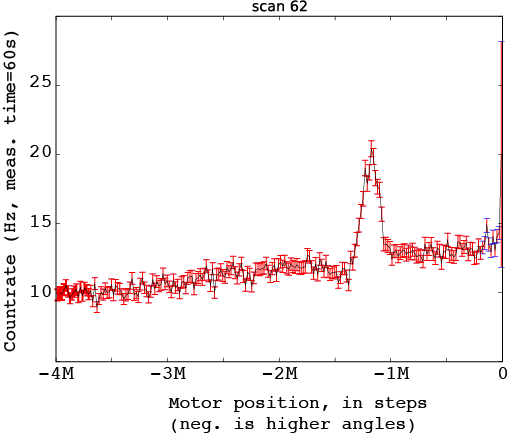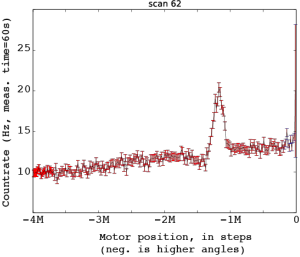
For the last two weeks, I have had the X-ray generator up and running. After installation of an old cooling system there were some troubles with the generator not turning on. These troubles were solved after a Rigaku engineer found a problem in one of the beam shutters, after which X-rays could be generated.
The instrument itself consists of two segments: a collimation section with a filter wheel and an additional shutter, and the dual-head rotation stage for the two Bonse Hart crystals. Fist up was the alignment of the collimation section.

The collimation section contains two slit positions, which are filled with (for now) a 0.5 mm slit and a 0.4 mm slit. This pair gives a maximum divergence of the x-rays of about 0.19 degrees. Using these slits, it was found that the optimum take-off angle from the target was 3 degrees (typically reported to be somewhere between 3 to 6 degrees). Surprisingly, this task took me a while as I had to program a position scanning method for a manual stage. After one week of adjustments, this alignment was complete.
The rotation stages were then roughly aligned using a laser pointer (shooting backwards from the detector position through both slits). After this, the first crystal was placed on the upstream rotation stage and further aligned so that the X-ray beam falls onto the approximate center of the crystal. For Mo-radiation used here, the reflection angle for Si(111) should be around 6.5 degrees, but scanning through that region gave me no indication of any reflection.
This went on for a week, until I decided to up the generator power (to 30 kV, 40 mA) and found a small bump. The bump visible here has a width of about 0.2 degrees, in line with the collimation system divergence. It is also very, very small. The tasks that lie ahead are to try to increase the height of the peak, reduce the background and perhaps check with the second crystal what the energy spectrum and beam divergence from the first crystal actually is. But for now, I am happy that something is visible!

Leave a Reply